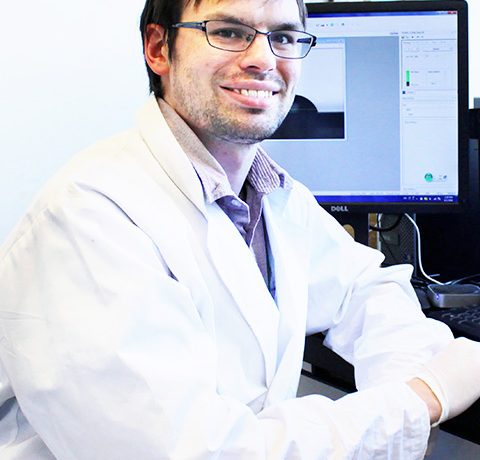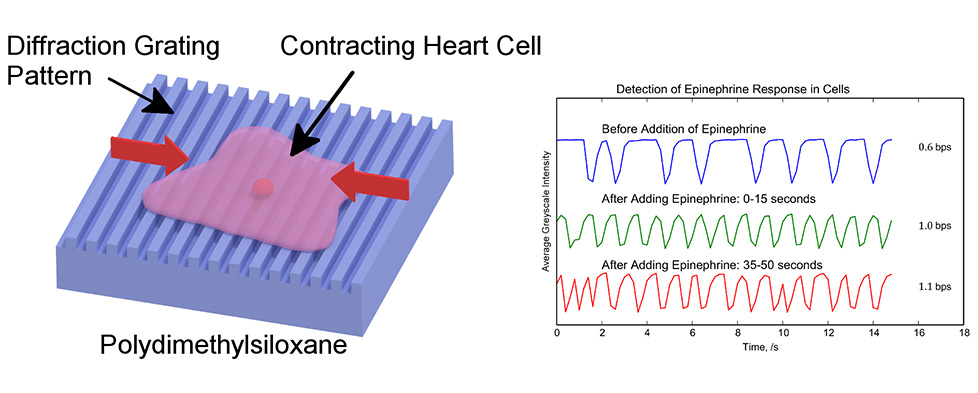A Graduate student in both the Koichiro Tanaka Lab and Easan Sivaniah Lab
Andrew Gibbons
Andrew Gibbons
Andrew Gibbons is a graduate student in the Physics Department at Kyoto University where he studies optical properties of polymer films. Recently Mr. Gibbons and his collaborators have developed a polymer film that changes color when heart cells are beating on its surface, providing a unique way of monitoring the cells.

Please share with us the significance of your manuscript in terms of its research achievements, impact, or uniqueness.

I suppose some context is needed to appreciate the impact of our research. During the early stages of drug development, there are many potential drugs that are considered and tested. One of the most important parts of these early stages is to weed out chemicals that can have harmful effects on different functions of the body, and relevant to our research is potential harm to the heart.
To help make this process more efficient we designed a substrate with optical structures that allows us to observe the beating rate of heart cells over a large surface area. Our substrate is a soft polymer with a diffraction grating pattern. As the cells contract, they deform the pattern causing a change in the observe color. Cell markers are not required for this method and measuring the beating of the cells is not invasive, giving it an advantage over the most common methods of observing heart cells. The method used to prepare the device is also surprisingly straightforward and accessible, one of the parts required is a simple CD disk. So we hope our optical substrate can be used to observe the effect that candidate drugs can have on the beating strength and beating rate of heart cells.
What would you say is the most exciting or “I made it!” moment during this research project?
There are a number of moments that stick out in my mind. One challenge of this project was that we had a number of ideas for how to make our optical substrate and a lot of them didn’t work for one reason or another. The “I made it” moment for me was after we first tried using diffraction gratings to make our film. The first time we added heart cells, it just worked, and we could see the effect they were having on our substrate surface very easily under the microscope.
Please tell us about the biggest challenge or problem you experienced while conducting your research. How did you overcome it?
Our optical substrate is made by molding a diffraction grating pattern into a polymer gel. One of our problems when developing this method was that our diffraction grating templates would get severely damaged by the process. The gratings are intended for sensitive optical experiments and are delicate and expensive, so this was making our method impractical. After thinking about this problem for a while I decide to try using a CD disk I had as a replacement for the expensive grating. Why not! It was a CD I was not using anymore. The CD worked better than I could have hoped, and it was reusable. So suddenly I have a grating mold that was cheap, durable, and could be bought at a nearby shop!
Would you consider this work to be a turning point in your overall research direction? If so, how has your research direction changed as a result of this work?
It’s hard to say, I am just beginning my research career so I’m not sure what my research direction was before this project. I would consider this to be my jumping off point. I always had the intention of doing some research with biomedical applications in mind, but I didn’t expect to do it this early, so I’m happy I had the opportunity to work on this project. This research project sticks out compared to other research I have been doing. My work recently has not involved any cell culturing and is focused on optical polymer films and their properties. We’ll see where I go after I graduate, I am open to doing more interdisciplinary research.
Please describe the current situation of your career. What is your current position? How has the knowledge and experience gained at iCeMS influencing your career?
I am still at the beginning of my research career. I should be graduating soon and I am still preparing for that. iCeMS has been a very supportive environment for me. My project would have been much more difficult if I did not have access to iCeMS’s cell culturing facilities, microscopes, and people with expertise. I am in the process of securing my next position and finding a research institute or company that brings together people from many different fields is a priority for me.
*All the information on this page, including the researcher’s affiliation, is current at the time of the interview.
Paper information
Real-time visualization of cardiac cell beating behaviour on polymer diffraction gratings
Andrew Gibbons, Orsi Lang, Yokji Kojima, Masateru Ito, Koh Ono, Koichiro Tanaka, Easan Sivaniah,
RSC Advances
Published: November 2017
DOI: 10.1039/c7ra06515a